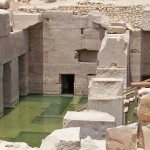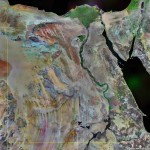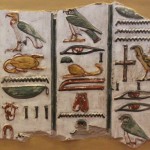Edition - July, 2011

Notes on the Osireion at Abydos
The Osireion was first excavated by Sir William Flinders Petrie, Margaret Murray and Petrie’s wife in the early 1900s. They found the tunnel and excavated towards what they called the “hypogeum.” It was full of sand and Roman filling when they began to clear it. Even before the full excavation of the site Murray speculated, convincingly, that “this was the building for the special worship of Osiris and the celebration of the Mysteries” [more…]

A few thoughts about duality and the desert
Brian Alm’s excellent introductory article on ancient Egyptian religion in Edition 1 of Egyptological, the first in a series of five articles on the topic, includes a section on duality. I have often pondered the extent to which the Egyptians segregated religious belief, which potentially formed an explanatory but idealized model of life, from everyday pragmatism. Duality is a good case in point. [more…]
Edition - June, 2011

The Geese of Meidum
This iconic painting from the Old Kingdom Mastaba of Nefermaat and Itet is in The Egyptian Museum in Cairo and consists of three pairs of birds on one register. The right-hand central pair are universally accepted as Red-breasted Goose, Branta ruficollis, and the left-hand central pair as Greater White-fronted Goose, Anser albifrons. [more…]

The Rekhyt
The hieroglyphs of the rekhyt, Gardiner sign G23 or G24 have previously only been identified as the “black”-backed Northern Lapwing Vanellus vanellus. However, apart from its colours, the Northern Lapwing has two other key identification features, a crest and a solid black breast. [more…]
Gantenbrink’s Door – Part I: the Orginal Discovery
Although we now know that there is chamber at the end of the shafts in the Queen’s Chamber of the Great Pyramid, I still remember first hearing in the late 1990s that something had been found. The whole affair was shrouded in secrecy, back in the days when Dr. Hawass was the Director in charge of the Giza Plateau rather than Minister of State, the position he holds today. [more…]

Television Review: Egypt’s Lost Cities
“Space Archaeology” is the new buzzword adopted by the BBC in its documentary “Egypt’s Lost Cities.” Not to be confused with the branch of archaeology studying orbiting space debris, it describes instead the use of satellite images to locate archaeological remains beneath the earth’s surface. [more…]

Studying Hieroglyphs Online – Some Observations
In 2009 I signed up to study the ancient Egyptian Language online through the Glyphstudy group. The Glyphstudy group is available, free of charge, to anyone interested in studying the grammar of ancient Egyptian. There are a number of groups under the Glyphstudy banner. [more…]
Edition - April, 2011
Book Review: Description de l’Egypte (Taschen 25th Anniversary Series)
Description de l’Egypte, Gilles Neret, Taschen 25th Anniversary Series (paperback edition), 2007. If you are interested in the images contained in Description de l’Egypte, the book produced by Napoleon’s “savants”, and particularly the illustrations of Pharaonic Egypt, this is a very good place to start. If you want an in-depth analysis of the background to Description, its purpose and a good sample of all the original sections and topics then you may be disappointed. [more…]
Book Review: Royal Women of Amarna
Although the Royal Women of Amarna is usually credited to Dorothea Arnold, it was in fact written by a panel of authors who each contributed a section: James P Allen’s contribution is a very short chapter on Atenism, The Religion of Amarna L Green wrote a somewhat longer Who’s Who? of the Amarna period Dorothy […] [more…]
 By
By